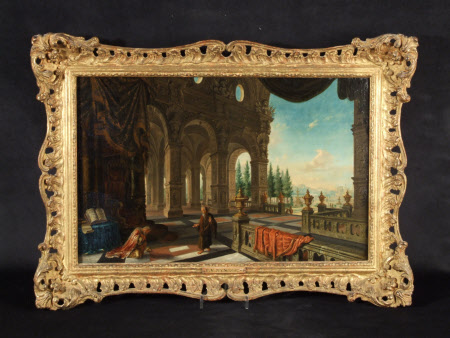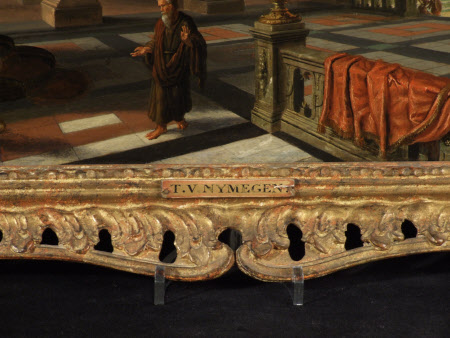Esther before Ahasuerus
Tobias van Nijmegen (b. Nijmegen c.1665)
Category
Art / Oil paintings
Date
1670 - 1699
Materials
Oil on copper
Measurements
292 x 470 mm (11 1/2 x 18 1/2 in)
Place of origin
Netherlands
Order this imageCollection
Hinton Ampner, Hampshire
NT 1530122.2
Caption
The biblical story of the Esther is told in the eponymous book of the Old Testament. King Ahasuerus (Xerxes) of Persia chose Esther, a Jew, as his queen after his original wife, Vashti, disobeyed him. Esther was originally presented to the King by her kinsman Mordecai, but she did not reveal she was Jewish until the King's chamberlain Haman ordered for all the Jews in the Kingdom to be slaughtered and their goods taken. Mordecai told Esther that it was her duty to go to the King and ask for mercy for her people. Esther knew that Ahasuerus had a rule that anyone who presented themselves to him unbidden would be executed, unless he touched them with his golden sceptre. Nonetheless she resolved to risk death to plead for the Jews to be spared. Esther is shown, in all her finery, presenting herself to Ahasuerus, who does extend his golden sceptre to her, so she swoons in relief. He granted her petition at a subsequent banquet; Mordecai was elevated to a high rank and the jealous Haman was hanged. Esther is celebrated in the Jewish festival of Purim and the Christian Church regard her as prefiguration of the Virgin Mary.
Summary
Oil painting on copper, Esther before Ahasuerus by Tobias van Nijmegen (b. Nijmegen c.1665), signed on pedestal of statue at left: T. V. NYMEGEN. Esther is kneeling in the centre accompanied by two female attendants and a boy holding the train of her dress. Two male figures stand slightly further back in the shadows. A tree-lined avenue of a formal garden stretches out in the distance behind in the sunshine, culminating in a fountain and two follies at either side. King Ahaseurus sits on a throne on a dais, on the right of an ornately-decorated entrance to a palace surmounted with gold statues, holding out his sceptre. He is under a canopy, supported by twisted Solomonic turquoise columns, with two stone sphinxes alongside and two stone lions which seem to have come to life and are leaving the steps. In the left foreground, in the shade, is a gigantic Apollo-like antique statue on a swag-decorated pedestal.
Provenance
Acquired by Ralph Dutton in 1966 from Christie's (receipt 26 May 1967); bequeathed by Ralph Dutton, 8th Lord Sherborne (1898–1985)
Credit line
Hinton Ampner, The Ralph Dutton Collection (National Trust)
Marks and inscriptions
On reverse: '114PJ' in black stencil On reverse: 'Oct. 21 66, July 23 66' in white chalk On reverse: 'Esther before the throne of Ahasuerus pleading for the Jews. signed Elias van(?) Nimegen' on label
Makers and roles
Tobias van Nijmegen (b. Nijmegen c.1665) , artist


